How-to Work with Qinsy Data
This How-to describes how to add and work with Qinsy data in Qimera (Versions 2.0.0 and up).
On this page:
For additional information, see our Getting Started guide.
Data
The data used for this How-to is single head EM2040C data from Brest, France, that was acquired using Qinsy and was provided by Université de Brest.
About Qinsy Data
The supported Raw Sonar format for Qinsy data is a DB file. These files are logged by Qinsy during online acquisition.
If Qinsy QPD files are available, they will be used in Qimera; otherwise, Qimera will generate new QPD files from the added DB files.
Qinsy QPD files can be added manually as Processed Point files, and Qinsy GRD grid files can be added using the Import Grid option in the Layer Menu.
Licensing
The import and processing of raw data formats is dependent on licensing. To view your license coverage in Qimera, go to the Help Menu and choose Show License Manager.
How Qimera Establishes the Coordinate Reference System
Qimera can use logged DBs, template DBs, or QPDs to establish the Project Coordinate Reference System (CRS).
This is the order that Qimera will use to establish the project CRS:
1) If Qimera is started directly from the Qinsy Console, the same CRS used in Qinsy will be used in Qimera.
2) If a DB is present, it will be used to establish the project CRS. This will work when opening a project for either Point Cleaning OR Full Sonar Processing. This is also the case when a DB is imported into a new Qimera project.
3) If a Qinsy project is opened and there is no logged DB present, the template DB (if present) will be used to set the Project CRS.
4) If there are no logged DBs or template DBs present, the QPDs will be used to set the Project CRS.
In all cases, the first valid source of a CRS definition will be used. If you have several CRS's defined across multiple DB's, templates, or QPD's, extra care must be taken that the correct CRS is set.
Once the CRS is set, it cannot be changed for a project.
How-to Bring Qinsy Data Into Qimera
You can choose to:
1) Open Qimera directly from the Qinsy console, which will automatically bring in all files into Qimera
2) Open an existing Qinsy project in Qimera, which will load the existing DB and QPD files (if the QPD files exist)
3) Or, create a New Project in Qimera and add the DB files as source files (QPDs can also be used to create a Qimera project if desired)
These options are reviewed below.
Option 1: Open Qimera from the Qinsy Console
1) From the Qinsy Console, click the Qimera button to launch Qimera.
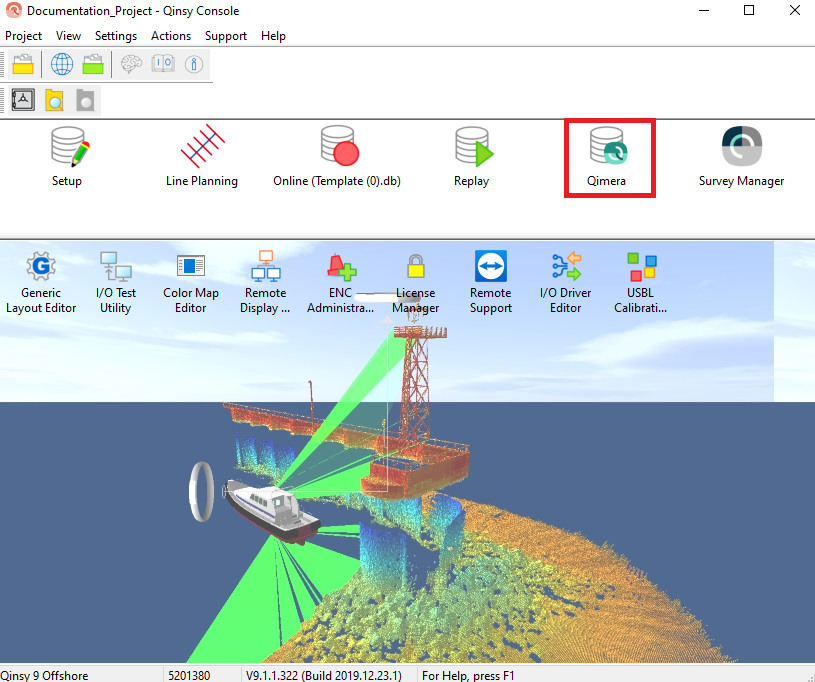
Figure 1: Opening Qimera from Qinsy Console
2) If your project contains both QPD's and DB files, a prompt dialog will appear asking how you want to open your project:
Figure 2: Qimera's Loading Qinsy Project Dialog, Point Cleaning or Full Sonar Processing
The option to choose Point Cleaning or Full Sonar Processing is license dependant. To view your license coverage in Qimera, go to the Help Menu and choose Show License Manager.
3) If you select Point Cleaning, Qimera will only load the QPD files from the DtmData Folder in the Qinsy project directory. The QPDs will be listed in the Project Sources under Processed Point Files. The project can be 'upgraded' to Full Sonar Processing by right-clicking on a QPD and selecting Load Associated DB File.
Qimera will automatically create new folders and files inside of the existing Qinsy project. These additional folders and files are used to maintain metadata, hold extracted information, and provide locations for newly created files.
Click here for an overview of the Qimera Project Structure and what is stored in each folder.
4) If you select Full Sonar Processing, Qimera will load the Qinsy project, scanning for and extracting any available information as it opens the project.
Click here for a full list of what is extracted from each supported format.
Extracted information for Qinsy projects can include:
- Processed multibeam if QPD files available
- Raw multibeam
- Water column imagery
- Vessel configuration
- SVP
- Surface sound speed
- Orientation
- Position
- Height
- Tide
- Pressure
- Sonar Settings
- Other (i.e. Snippets)
As the project opens, DB files will be listed in the Project Sources Dock under Raw Sonar Files. In Figure 3 you can see:
- Indicators showing the loading progress of each individual file in the Project Sources Dock,
- The loaded tracklines visualized in the 4D Scene,
- The overall progress of data extraction in the Job Activity Dock,
- Any warnings or errors shown in the Job Activity Dock.
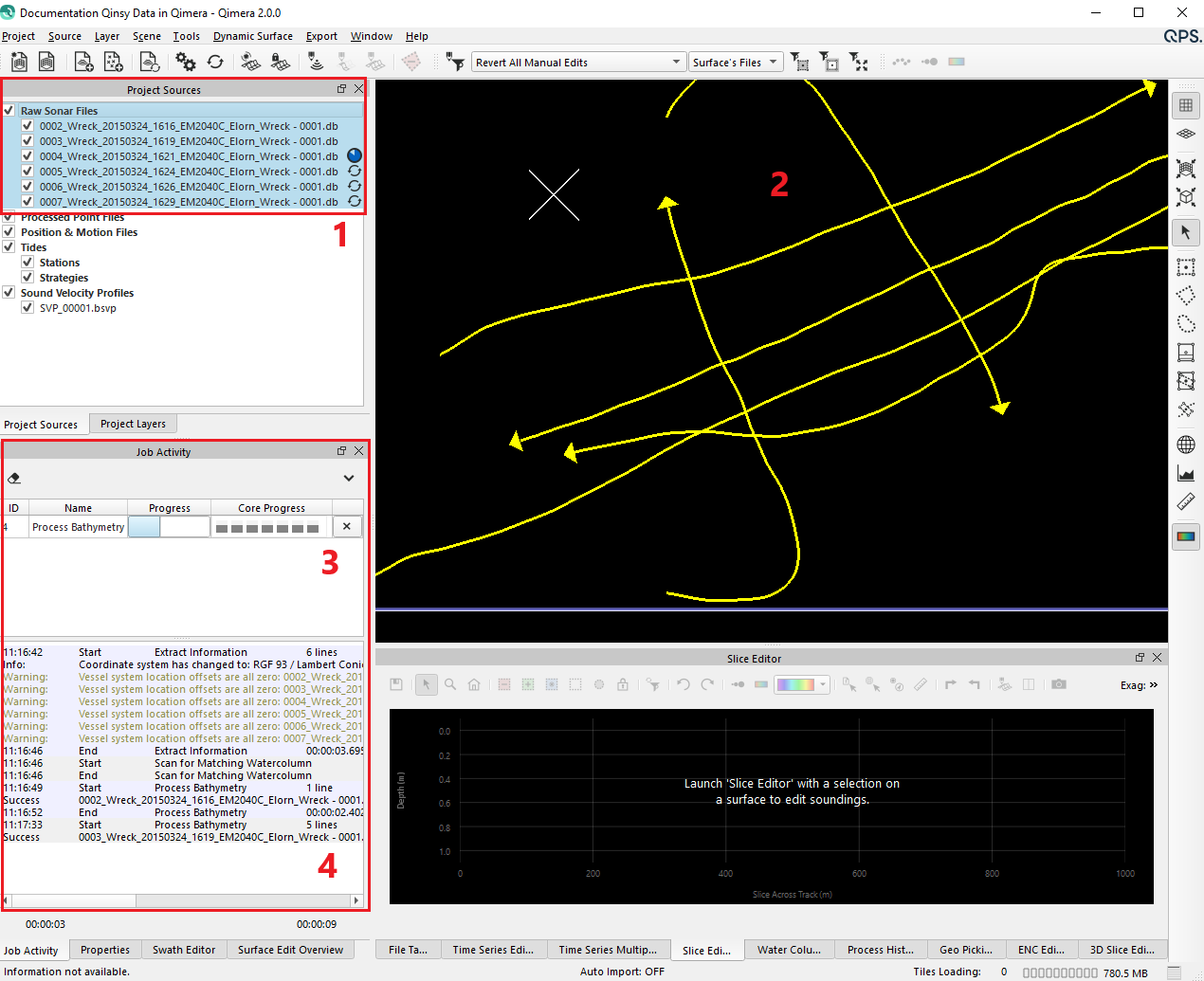
Figure 3: Information being extracted from the Qinsy Project During Load
5) Once the project data extraction is complete, you can review:
- All of the DB files from the project will be shown in the Project Sources Dock under Raw Sonar Files,
- And any encountered errors in the Job Activity Dock.
In this example dataset, the Job Activity Dock displays a warning that the "Vessel system location offsets are all zero". 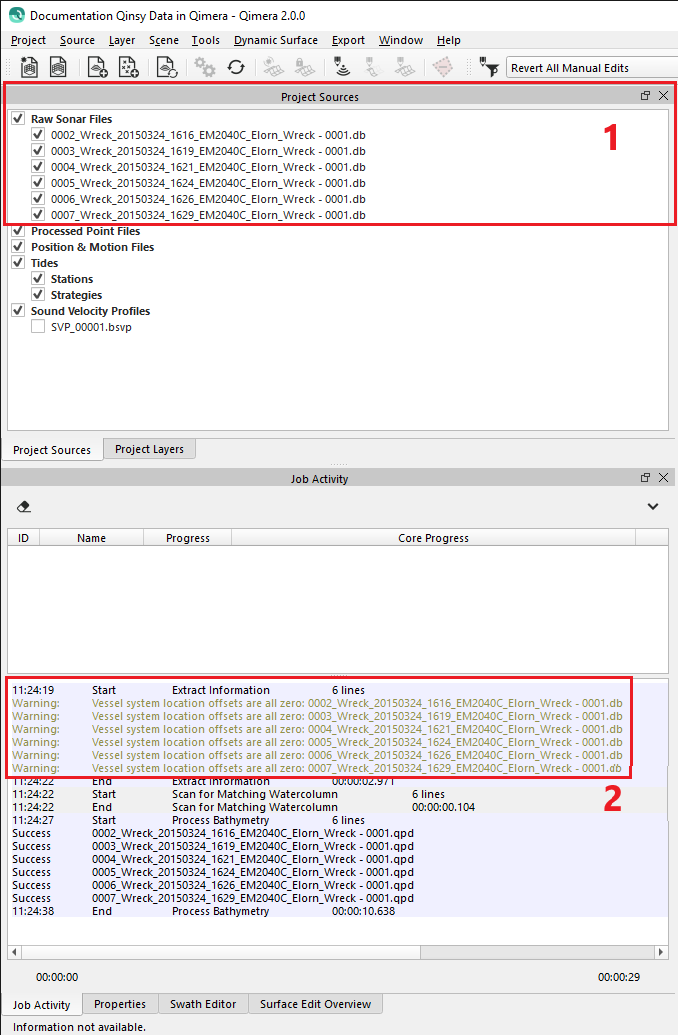
Figure 4: Data Extraction Complete
6) As information is extracted from the Qinsy files, the additional folders that Qimera created in the project get populated with the information.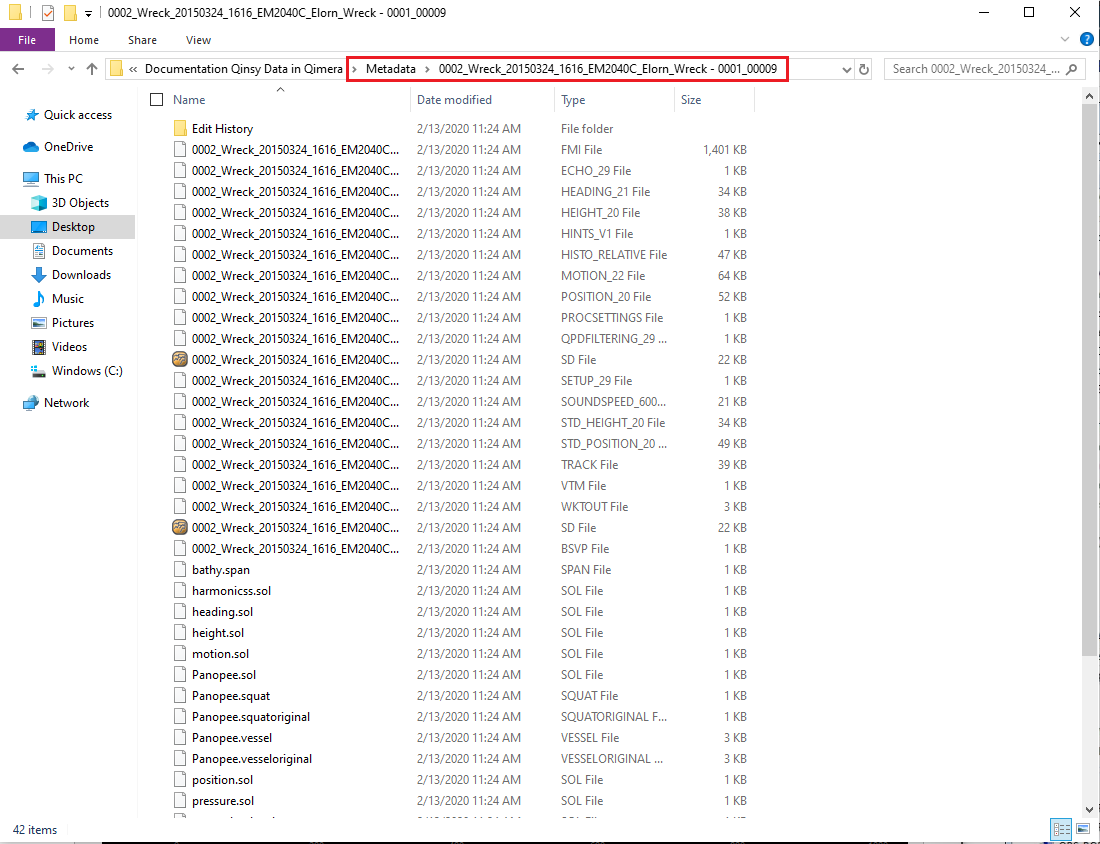
Figure 5: Extracted Information for Line 0002 in the Metadata Folder
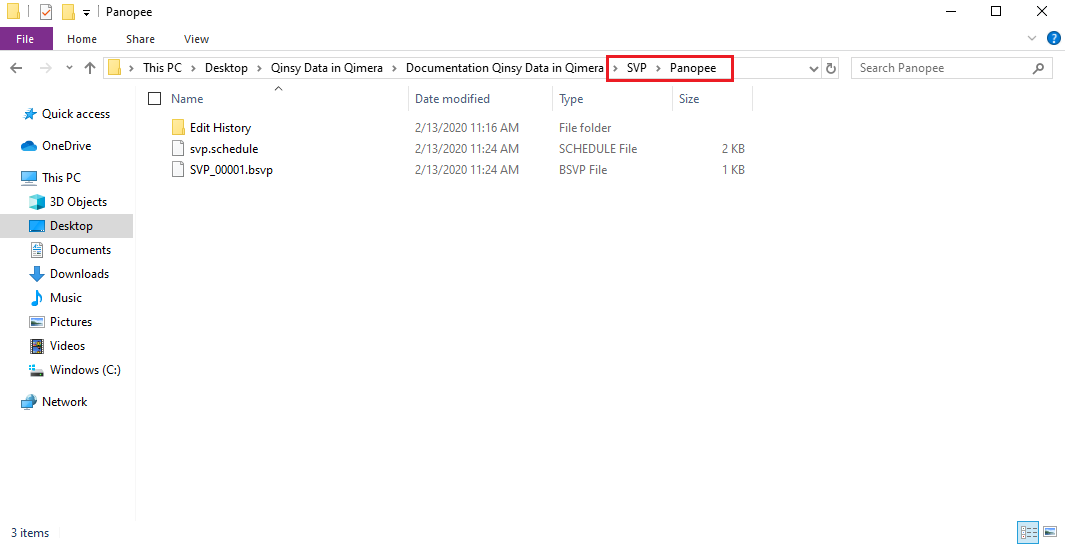
Figure 6: Extracted SVP Information in the SVP Folder
Dynamic Surface Created in Qinsy
If there are any Dynamic Surfaces that were built by Qinsy while Online or in the Processing Manager, these will be detected by Qimera and loaded automatically.
Option 2: Opening an Existing Qinsy Project
1) After you open Qimera, the Projects Dialog will launch. Select Open Other... to open the File Explorer.
Figure 7: Qimera's Projects Dialog, Open Other... option
Alternatively, you can open a project by clicking the Open Project Button 
2) Navigate to and select the parent folder of your Qinsy project.
Figure 8: File Explorer, Selecting the Qinsy Project Directory
3) If your project contains both QPD's and DB files, a prompt dialog will appear asking how you want to open your project:
Figure 9: Qimera's Loading Qinsy Project Dialog, Point Cleaning or Full Sonar Processing
4) If you select Point Cleaning, Qimera will only load the QPD files from the DtmData Folder in the Qinsy project directory. The QPDs will be listed in the Project Sources under Processed Point Files. The project can be 'upgraded' to Full Sonar Processing by right-clicking on a QPD and selecting Load Associated DB File.
Qimera will automatically create new folders and files inside of the existing Qinsy project. These additional folders and files are used to maintain metadata, hold extracted information, and provide locations for newly created files.
Click here for an overview of the Qimera Project Structure and what is stored in each folder.
5) If you select Full Sonar Processing, Qimera will load the Qinsy project, scanning for and extracting any available information as it opens the project.
Click here for a full list of what is extracted from each supported format.
Extracted information for Qinsy projects can include:
- Processed multibeam if QPD files available
- Raw multibeam
- Water column imagery
- Vessel configuration
- SVP
- Surface sound speed
- Orientation
- Position
- Height
- Tide
- Pressure
- Sonar Settings
- Other (i.e. Snippets)
As the project opens, DB files will be listed in the Project Sources Dock under Raw Sonar Files. In Figure 10 you can see:
- Indicators showing the loading progress of each individual file in the Project Sources Dock,
- The loaded tracklines visualized in the 4D Scene,
- The overall progress of data extraction in the Job Activity Dock,
- Any warnings or errors shown in the Job Activity Dock.

Figure 10: Information being extracted from the Qinsy Project During Load
6) Once the project data extraction is complete, you can review:
- All of the DB files from the project will be shown in the Project Sources Dock under Raw Sonar Files,
- And any encountered errors in the Job Activity Dock.
In this example dataset, the Job Activity Dock displays a warning that the "Vessel system location offsets are all zero". 
Figure 11: Data Extraction Complete
7) As information is extracted from the Qinsy files, the additional folders that Qimera created in the project get populated with the information.
Figure 12: Extracted Information for Line 0002 in the Metadata Folder

Figure 13: Extracted SVP Information in the SVP Folder
Dynamic Surface Created in Qinsy
If there are any Dynamic Surfaces that were built by Qinsy while Online or in the Processing Manager, these will be detected by Qimera and loaded automatically.
Option 3: Creating a New Project & Adding Raw Sonar Data
1) After you open Qimera, the Projects Dialog will launch. Select New Project... to open the Create Project Dialog.
Figure 14: Qimera's Projects Dialog, New Project... Option
Alternatively, you can create a project by clicking the Create Project Button 
2) Fill in Project Details:
- Add a project name.
- By default, the folder for your project will be in the 'C:\Users\username\QPS-Data\' directory, though you can choose another location.
- The Survey Type and Description boxes can be used to add additional notes about the project.
- Set the Project Coordinate System (CRS):
- Automatic - Qimera will automatically extract the project coordinate system from Qinsy DB files. Qimera will choose an appropriate UTM zone when loading data from Reson (.s7k) or Kongsberg (.all) files by looking at the geographic navigation extents. If you are loading Hypack (.hsx) files, the Automatic option will not work. It is required to choose Single Projected, or Full Geodetic Configuration,
- Single Projected - If you would like your Qimera products (QPDs, surfaces, etc.) to be in a projection that differs from your source files, you can manually set the CRS from a list of pre-defined CRS using the Search Coordinate System Dialog.
- Full Geodetic Configuration - If you would like your Qimera products (QPDs, surfaces, etc.) to be in a projection that differs from your source files and is not included in the list of pre-defined CRS, you can manually enter the geodetic configuration parameters. A Geodetic Configuration consists of, at minimum, a Project CRS. Additionally, it can contain an Input Geographic CRS and optionally a Transformation between the Project CRS and the Input Geographic CRS. You can also optionally have a Vertical CRS. This is done using the Geodetic Configuration Overview Dialog.
Figure 15: Create Project Dialog
3) Once the Project CRS is set, click OK to create the project. Once created, the Project Folder will contain sub-folders for storing bathymetry files in QPD format, internal metadata, extracted external source data, and products.
4) You will be prompted to add source files to your new project. Choose Add Raw Sonar Files.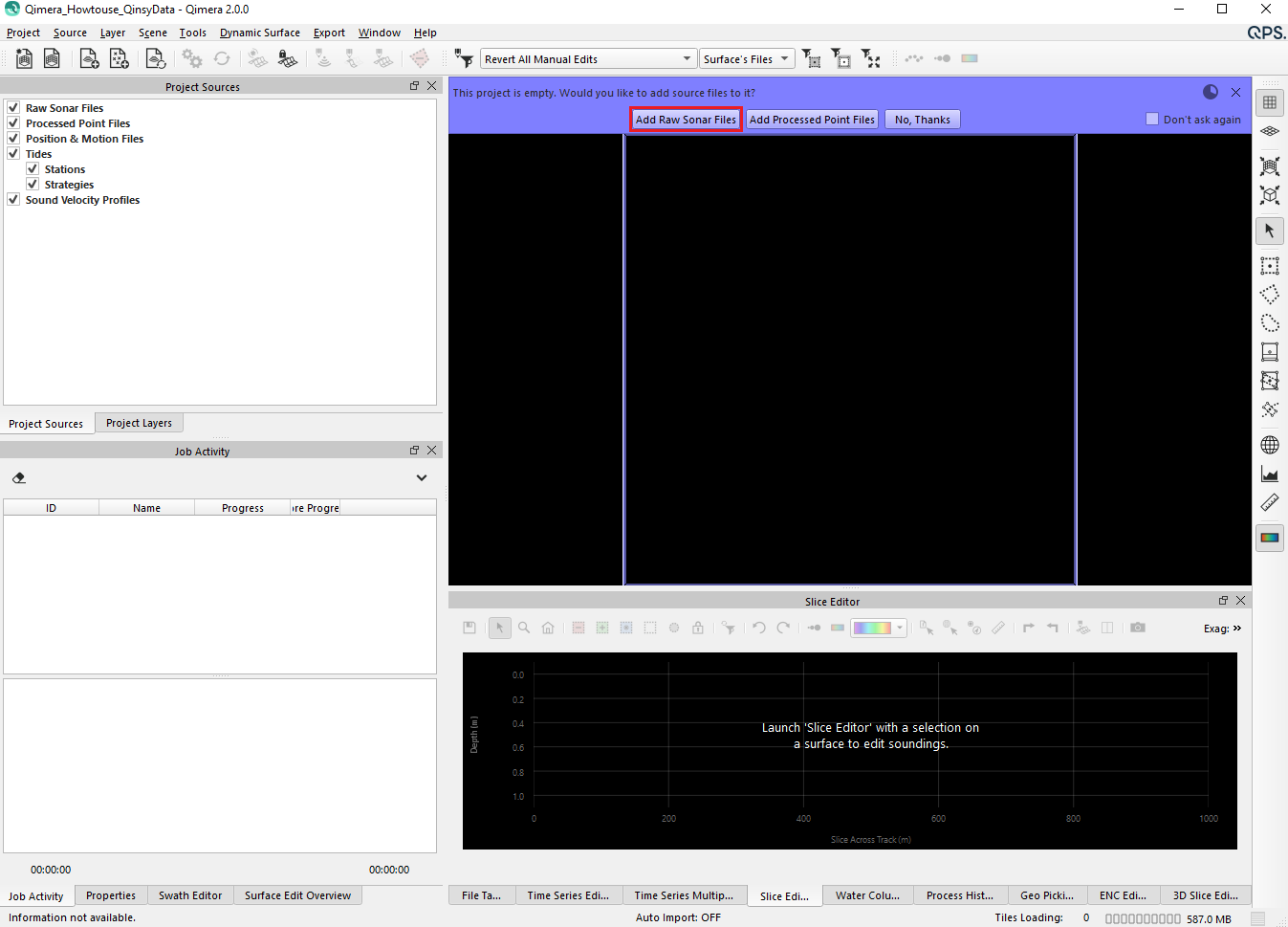
Figure 16: Add Raw Sonar Files Prompt
Alternatively, you can add Raw Sonar Source Files by clicking the Add Raw Sonar File Button 
5) Use the Add Files... Button to navigate to and select the DB files from the Database folder of your Qinsy project. Click OK to load the files.
Figure 17: Add Raw Sonar Files Wizard
Coordinate System information can be read directly from the DB files, so setting this information in the import wizard is not an option.
6) Qimera will load the Qinsy DB files, scanning for and extracting any available information and writing it to the Qimera project.
For a full list of what is extracted from each supported format, click here.
DB files will be listed in the Project Sources Dock under the Raw Sonar Files.
Extracted information for Qinsy data can include:
- Processed multibeam if QPD files available
- Raw multibeam
- Water column imagery
- Vessel configuration
- SVP
- Surface sound speed
- Orientation
- Position
- Height
- Tide
- Pressure
- Sonar Settings
- Other (i.e. Snippets)
Shown below are:
- Indicators showing the loading progress of each individual file in the Project Sources Dock.
- The loaded tracklines visualized in the 4D Scene.
- The overall progress of data extraction in the Job Activity Dock.
- Any warnings or errors shown in the Job Activity Dock.

Figure 18: Information Being Extracted from the Qinsy Project During Load
7) As the data loads, QPD files will be generated and written to the Qimera project. Once the data is loaded, ancillary data extraction, and the QPD write is complete.
You will see:
- All of the DB files from the project will be shown in the Project Sources Dock under Raw Sonar Files.
- The loaded tracklines visualized in the 4D Scene.
- Any encountered errors in the Job Activity Dock.
- And the extracted QPD information in the File Table Dock.
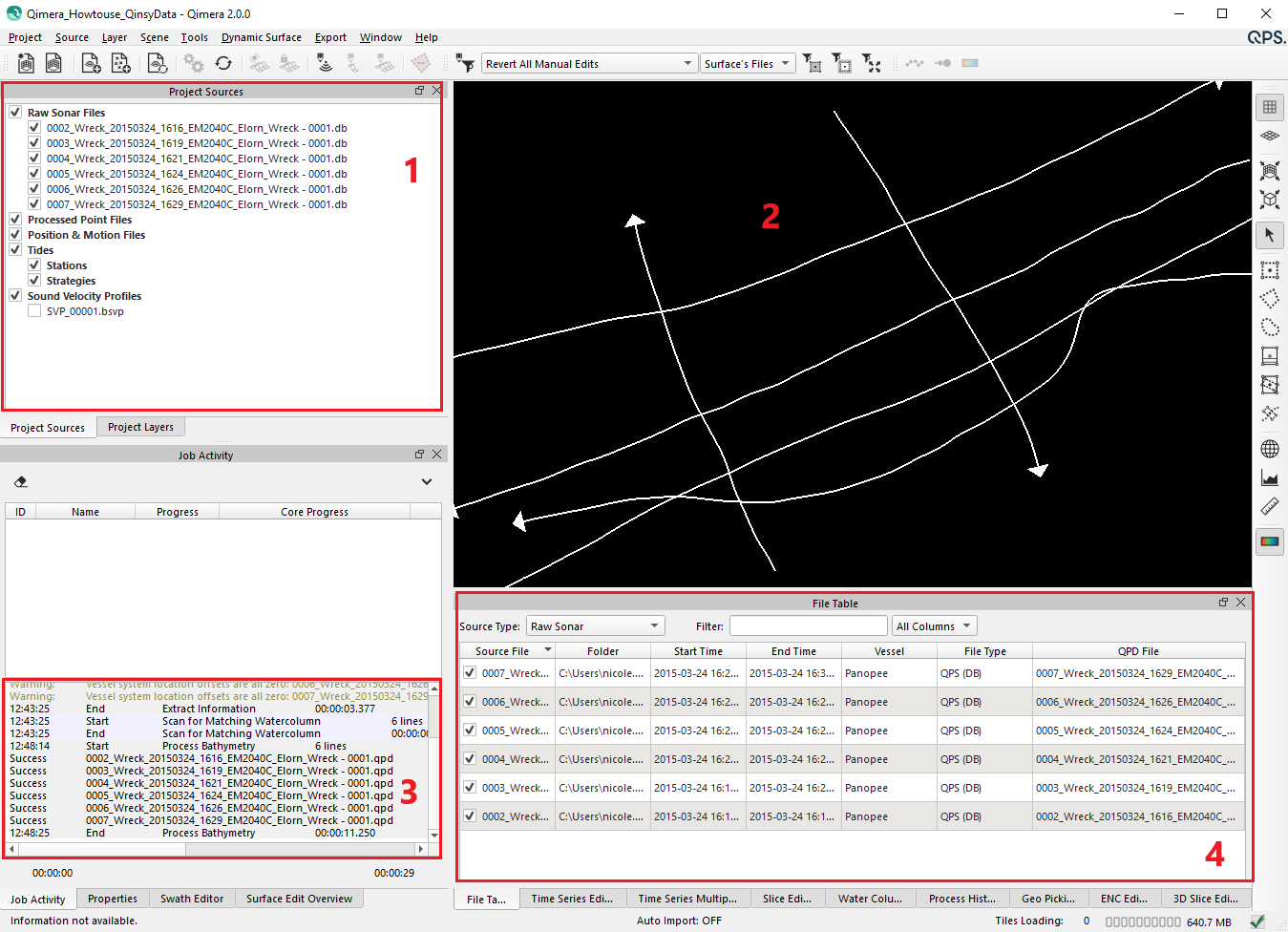
Figure 19: File Table Populated with Information and Errors/Issues Encountered in Job Activity Dock
8) As information is extracted from the Qinsy files, the folders in the Qimera project get populated with the information.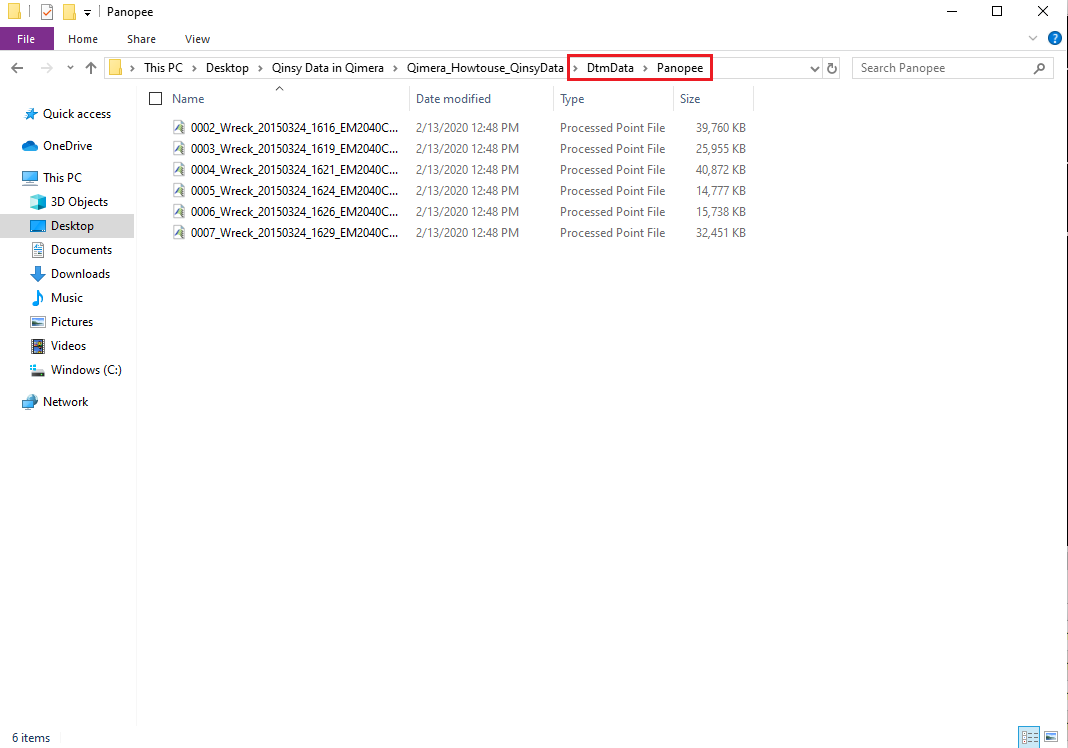
Figure 20: Newly Generated QPDs in the Qimera Project DtmData Folder

Figure 21: Extracted Information for Line 0002 in the Metadata Folder

Figure 22: Extracted SVP Information in the SVP Folder
No QPD's in Project
When a project doesn't contain QPD files, the DB files in the Project Sources Dock will be followed by the 

Figure 23: DB Files with Indication that Reprocessing is Required
Older QPD's in Project
When a project containing older QPD1 files (Qimera 1.0) is loaded into a newer version of Qimera (1.1 to 1.7, and 2.x), a popup warning will appear stating that the QPDs require updating.
Qimera will automatically regenerate the files in the upgraded QPD2 format and write the new files to the Qinsy project. The process will be noted in the Job Activity Dock shown below.
Figure 24: Upgraded Files in the Job Activity Dock
After you upgrade the project, it will not be supported in older versions of QPS software (Qimera 1.0 and Qinsy 8.10 or previous).
Vessel Offsets Equal Zero
In this example dataset, the Job Activity Dock displays a warning that the "Vessel system location offsets are all zero", as well as a prompt noting that "Your vessel offsets are all zero. Would you like to edit your vessel settings now?"
Click Yes at the prompt to open the Vessel Editor (or Tools Menu -> Vessel Editor).
A review of the settings in the Vessel Editor will show that the Starboard, Forward, and Up Transducer Offsets are all set to zero.
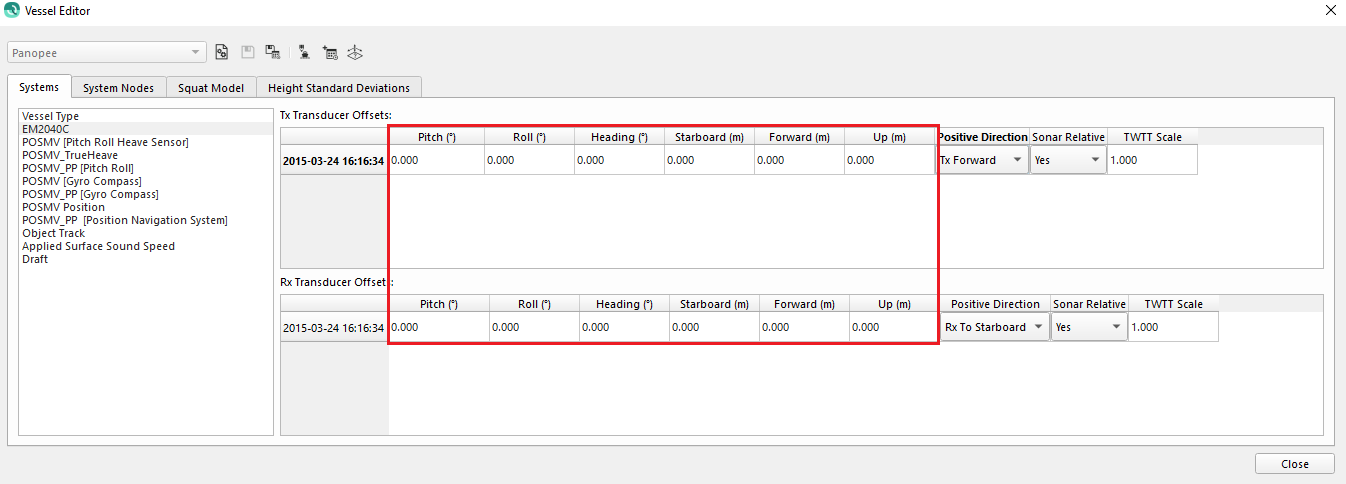
Figure 25: Vessel Offsets Set to Zero in the Vessel Editor
This vessel was equipped with a POSMV, and all referencing was done to the POS rather than in Qinsy. This is a typical warning for this set-up and is not a cause for concern, therefore no action is necessary in this particular case.
Visualizing a File in Qimera
Checking a file ON or OFF in the Project Sources Dock controls the visibility of the trackline.
Checking a file ON or OFF does not effect which files are used in surface creation and processing routines.

Figure 26: File Checked ON in Project Sources Dock

Figure 27: File Checked OFF in Project Sources Dock
Selecting a File in Qimera
For files to be used in a processing routine (such as Surface Creation), they can be checked ON or OFF, but they must also be selected.
Files can be selected by clicking on the file name or trackline with the mouse (use SHIFT-click or CTRL-click to select multiple files), or by selecting the parent directory above the files in the Project Sources Dock. The parent directory in Figure 28 is "Raw Sonar Files."
In this example, only lines 0002 & 0003 are selected.

Figure 28: Files Selected in Project Sources Dock
This is a key part of Qimera's workflow. For an overview of the Qimera user interface, click here.
Note: When lines have just been added to your project and you are prompted to do a process, all of the lines that were added will automatically be included in that process.
Auto-Import of QGF from Qinsy projects
- When opening a Qinsy project for the first time, any QGF Survey Line files (.qgfline and .qgfback) will be found and converted to .sd format and added to the Project Layers
- Since .sd objects can only contain one object type per file (e.g. points in one file, lines in another), a QGF is "exploded" into a points and a lines .sd files. And the objects are named the same as the layer they belonged to. These are added under a single group with the group name coming from the QGF. Visibility can be controlled separately for points and lines as well using the normal mechanisms.
